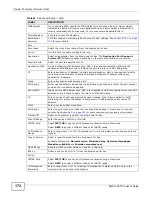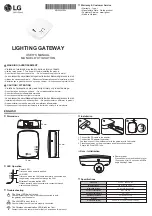
Chapter 15 Quality of Service (QoS)
AMG1302-T10A User’s Guide
174
15.3 QoS Technical Reference
This section provides some technical background information about the topics covered in this
chapter.
15.3.1 IEEE 802.1p
IEEE 802.1p specifies the user priority field and defines up to eight separate traffic types. The
following table describes the traffic types defined in the IEEE 802.1d standard (which incorporates
the 802.1p).
15.3.2 IP Precedence
Similar to IEEE 802.1p prioritization at layer-2, you can use IP precedence to prioritize packets in a
layer-3 network. IP precedence uses three bits of the eight-bit ToS (Type of Service) field in the IP
header. There are eight classes of services (ranging from zero to seven) in IP precedence. Zero is
the lowest priority level and seven is the highest.
IPP/TOS (DSCP)
This shows the IPP/TOS or DSCP settings.
802.1p
This is the 802.1p priority level.
Actions
IPP/TOS (DSCP)
Remarking
The Device re-assigns the priority values specified in this field to matched traffic.
802.1p Remarking
The Device re-assigns the priority levels specified in this field to matched traffic.
Queue #
The Device assigns the queue level specified in this field to matched traffic.
Table 65
Advanced Setup > QoS > Rule&Action Summary
LABEL
DESCRIPTION
Table 66
IEEE 802.1p Priority Level and Traffic Type
PRIORITY
LEVEL
TRAFFIC TYPE
Level 7
Typically used for network control traffic such as router configuration messages.
Level 6
Typically used for voice traffic that is especially sensitive to jitter (jitter is the variations in
delay).
Level 5
Typically used for video that consumes high bandwidth and is sensitive to jitter.
Level 4
Typically used for controlled load, latency-sensitive traffic such as SNA (Systems Network
Architecture) transactions.
Level 3
Typically used for “excellent effort” or better than best effort and would include important
business traffic that can tolerate some delay.
Level 2
This is for “spare bandwidth”.
Level 1
This is typically used for non-critical “background” traffic such as bulk transfers that are
allowed but that should not affect other applications and users.
Level 0
Typically used for best-effort traffic.
Содержание AMG1302-T10A
Страница 4: ...Contents Overview AMG1302 T10A User s Guide 4 ...
Страница 12: ...Table of Contents AMG1302 T10A User s Guide 12 ...
Страница 13: ...13 PART I User s Guide ...
Страница 14: ...14 ...
Страница 20: ...Chapter 1 Introduction AMG1302 T10A User s Guide 20 ...
Страница 52: ...Chapter 4 Tutorials AMG1302 T10A User s Guide 52 ...
Страница 53: ...53 PART II Technical Reference ...
Страница 54: ...54 ...
Страница 126: ...Chapter 8 Wireless LAN AMG1302 T10A User s Guide 126 ...
Страница 140: ...Chapter 9 Network Address Translation NAT AMG1302 T10A User s Guide 140 ...
Страница 158: ...Chapter 11 Filters AMG1302 T10A User s Guide 158 ...
Страница 162: ...Chapter 12 Static Route AMG1302 T10A User s Guide 162 ...
Страница 166: ...Chapter 13 Port Binding AMG1302 T10A User s Guide 166 ...
Страница 176: ...Chapter 15 Quality of Service QoS AMG1302 T10A User s Guide 176 ...
Страница 198: ...Chapter 18 Universal Plug and Play UPnP AMG1302 T10A User s Guide 198 ...
Страница 202: ...Chapter 19 CWMP AMG1302 T10A User s Guide 202 ...
Страница 206: ...Chapter 20 System Settings AMG1302 T10A User s Guide 206 ...
Страница 216: ...Chapter 21 Logs AMG1302 T10A User s Guide 216 ...
Страница 266: ...Appendix C Pop up Windows JavaScripts and Java Permissions AMG1302 T10A User s Guide 266 ...
Страница 280: ...Appendix D Wireless LANs AMG1302 T10A User s Guide 280 ...
Страница 290: ...Appendix E IPv6 AMG1302 T10A User s Guide 290 ...
Страница 322: ...Appendix G Legal InformationSafety Warnings AMG1302 T10A User s Guide 322 ...
Страница 331: ...Index AMG1302 T10A User s Guide 331 ...
Страница 332: ...Index AMG1302 T10A User s Guide 332 ...
















































